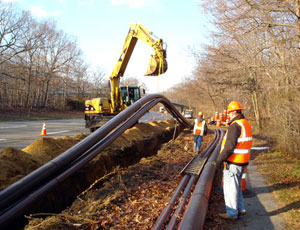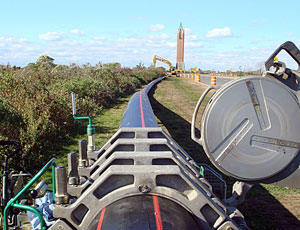Independent transmission developers in both the northeastern and northwestern U.S. looking to bring Canada’s renewable electricity resources to power-hungry regions south of the border are installing hundreds of miles of line by using the path of least resistance—underwater.


“There’s a trend toward acceptance of this technology and this market,” says Christer Erikkson, director of business development at ABB Power Systems, a division of ABB Group, Zurich, Switzerland. The firm is one of the major manufacturers for high-voltage, direct- current (HVDC) lines and converter stations. “It’s easier to lay a cable underwater, and it’s generally better accepted because it’s out of sight, out of mind,” he adds, noting that in some cases, an underwater cable is the only option.
The U. S. Energy Dept. is now considering loan guarantees for two projects that would cross the U.S.-Canadian border by water.
The relatively modest Juan de Fuca Cable would travel 31 miles along the bottom of the Strait of Juan de Fuca, from Vancouver, B.C., to Washington state’s Olympic Peninsula. The $480-million project would carry 450 MW of power on an HVDC line. Developers have secured all necessary permits and, pending financing arrangements, could begin construction this year. ABB is a partner in the line and likely would handle its construction, says Paul Manson, president and CEO of Sea Breeze Corp., the Vancouver-based energy firm that is developing the transmission project.
One of the backers of the Juan de Fuca cable is Boundless Energy, York Harbor, Maine. Boundless also helped develop the Neptune line, a 50-mile underwater HVDC line installed in the Atlantic Ocean and New York Harbor in 2007 to carry 660 MW of power from New Jersey to Long Island.
Developers of a second project, which is 10 times longer, have just begun the federal regulatory process seeking to install two HVDC lines from Quebec province to metropolitan New York City and then to Bridgeport, Conn. Those 415 miles of line would be installed in waterways and under the Hudson River and Lake Champlain to provide 2,000 MW of renewable power. The project is estimated to cost $3.8 billion, and developers anticipate beginning construction late next year.
New technology allows HVDC lines to be manufactured without oil, making them more environmentally sound for underwater installation. Additionally, a growing demand for renewable power without unsightly overhead transmission lines has made HVDC cables an attractive option, says Don Jessome, president of Transmission Developers Inc., Toronto, a developer of the Champlain-Hudson Power Express. “I don’t think you could ever build an overhead transmission line” along that underwater line’s path, he says.
Unlike alternating-current (AC) lines, direct-current lines must have expensive converters at each end to convert the power. However, DC lines can carry electricity an almost infinite distance without losing much, if any, of the current, making them ideal to carry large loads of electricity over long distances. AC lines cannot carry power farther than about 40 miles, says Steve Eckroad, superconductivity program manager at Electric Power Research Institute, Palo Alto, Calif.
The Champlain-Hudson would be almost a direct line from new hydroelectric power and other renewable sources in upper Quebec and upstate New York to metropolitan areas. The cable would begin in the Richelieu River in Quebec and then travel south through Lake Champlain and along railroad rights-of-way, avoiding environmentally sensitive areas such as the General Electric Co. PCB cleanup site in the upper Hudson River. The cable would enter the Hudson River south of Albany and deliver power to converter stations in Yonkers, N.Y., and Bridgeport, Conn.
Jessome says Transmission Developers is still in discussions with HVDC providers and contractors but has completed engineering studies of the route. Installing the cable would require use of a highly specialized boat that can carry about 60 miles of cables. Using global positioning systems and thrusters, the ship is able to lay the cable within 1 meter along the route. A special water jet, or water plow, digs a trench ranging from 3 ft to 6 ft to lay the line, which must be buried deep enough to avoid colliding with an anchor.
Developers of the Juan de Fuca and Champlain-Hudson lines have yet to firm up negotiations with generators, which will pay for access to the lines, and utilities, which will pay for the power, but both say discussions are ongoing.









Post a comment to this article
Report Abusive Comment